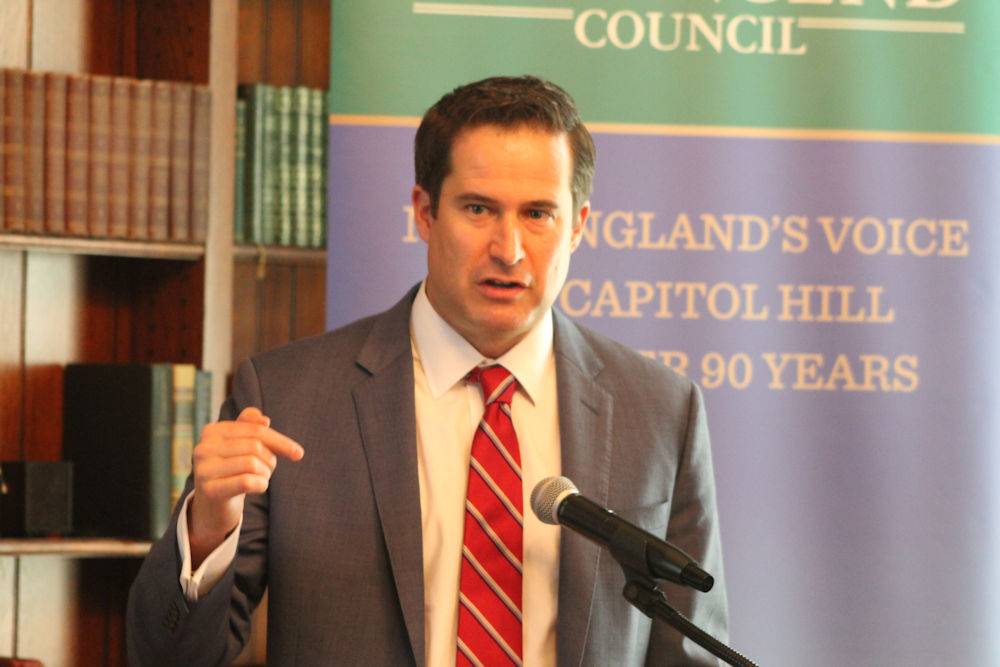CONGRESSMAN SETH Moulton is renewing his push for an underground rail connection between North Station and South Station in Boston, this time armed with two new pieces of information.
One is a just-completed study from the Harvard Kennedy School weighing the cost and benefits of addressing growing congestion at South Station by adding more tracks there (which is the current plan) or by connecting South Station and North Station. The study, commissioned by Moulton and presented so far only in graphic form, concludes that linking North Station and South Station would not only solve the congestion problem at South Station but also allow the development of a seamless commuter rail system running north and south, east and west – not split in half because of a missing three-mile link.
Combined with more frequent rail service, the study estimates the new rail tunnel would yield more than $28 billion in economic benefits, far more than the projected cost of $7.9 billion. It’s a lot of money, but Moulton insists it would be money well spent.
“We are not going to fix Massachusetts transportation problems by thinking small. We’ve got to think big,” Moulton said on The Codcast. “I mean it just makes no sense – the system we have today. So it has to be transformed, and if Massachusetts is ever going to fix our infamous transportation problems, this is the approach we need to take.”
The other new piece of information from Moulton is a name change. For years, the proposed project has been called the North-South Rail Link, but the congressman says it should be called only the Rail Link.
“A lot of people think of this as just like some sort of shuttle or another subway between the two stations, and that’s not what it is at all,” Moulton said. “It’s not just about going north or south, it’s about connecting every destination in the East with every destination in the West, which when you have a long rectangular state like Massachusetts, of course, is really important. This is good for everyone in the Commonwealth, and we want to make sure people understand that.”
In Moulton’s eyes, a rail link would allow Amtrak trains from the north to head uninterrupted through Boston and on to points to the south – and vice versa. Commuter rail trains would also connect travelers to destinations south, west, and north of the city without the need to get off a train and make an interim short trip to either South Station or North Station to complete a journey.
“No matter where you’re going on the commuter rail network that exists today, you would have a direct connection and that means you can get where you’re going faster than driving. That’s the key,” Moulton said. “Creating a system where people can get around Massachusetts faster than driving, that’s what encourages so many people to ride the rails.”
Moulton argues the Rail Link would give people more access to housing and jobs. “I live in Salem, Massachusetts,” he said. “I would never take a job on the South Shore because you can’t get there from Salem, certainly not at rush hour. That could be a two-hour trip in one direction. With the Rail Link, it would be about 40 minutes. So it’s totally transformative. You can live on the North Shore and work on the South Shore. You can live in Worcester and get to the Cape on a Friday afternoon in the summer in no time at all, whereas you could be sitting for three hours in traffic. We know how bad that can get. That’s why it’s so transformative and incentivizes so much housing.”
It sounds enticing, but the idea has been kicking around in one form or another since World War I and it’s never gotten off the ground. There have always been concerns about the cost, the depth of the tunnels, and the environmental risks.
Moulton suggests the opposition is unwarranted, and blames it on a fear of “doing big” – a fear fanned by the cost overruns associated with the Big Dig. “As difficult as the Big Dig was at the time, everyone is so grateful for how it transformed downtown Boston. But this is actually a lot easier than the Big Dig,” Moulton said. “It costs way less and is something that dozens of cities all around the globe, including other cities in America, have already done. It’s a very deep tunnel that goes right under the center of the city. You would not even know it’s under construction when it’s being built. Just a couple exits in the south and one in the north for the tunnel boring machine to go into the ground. And so it causes almost no disruption to the city while it’s being built.”
The congressman also says he would not give the job of constructing the tunnel to the MBTA. Instead, he said, the best approach would be to hire private companies to perform the work under public oversight. “Don’t think for a second we’d expect the T to take this on when they can barely handle what they’ve got,” he said.
The Rail Link has barely been mentioned of late at the MBTA, in the Legislature, or by a task force created by Gov. Maura Healey to come up with a way to fund the transportation system in Massachusetts. Moulton is not dissuaded, insisting that the Healey administration is open to a discussion of the Rail Link.
“We could expand South Station and the project would literally be obsolete in less than 20 years,” Moulton said. “That would be a historic waste of taxpayer money. Or we could build a Rail Link that will last for a century that will transform travel all around Massachusetts. That’s the choice that we have to make, and ultimately the governor’s responsible for making that choice.”
The post Moulton again is championing the idea of a ‘Rail Link’ appeared first on CommonWealth Beacon.

